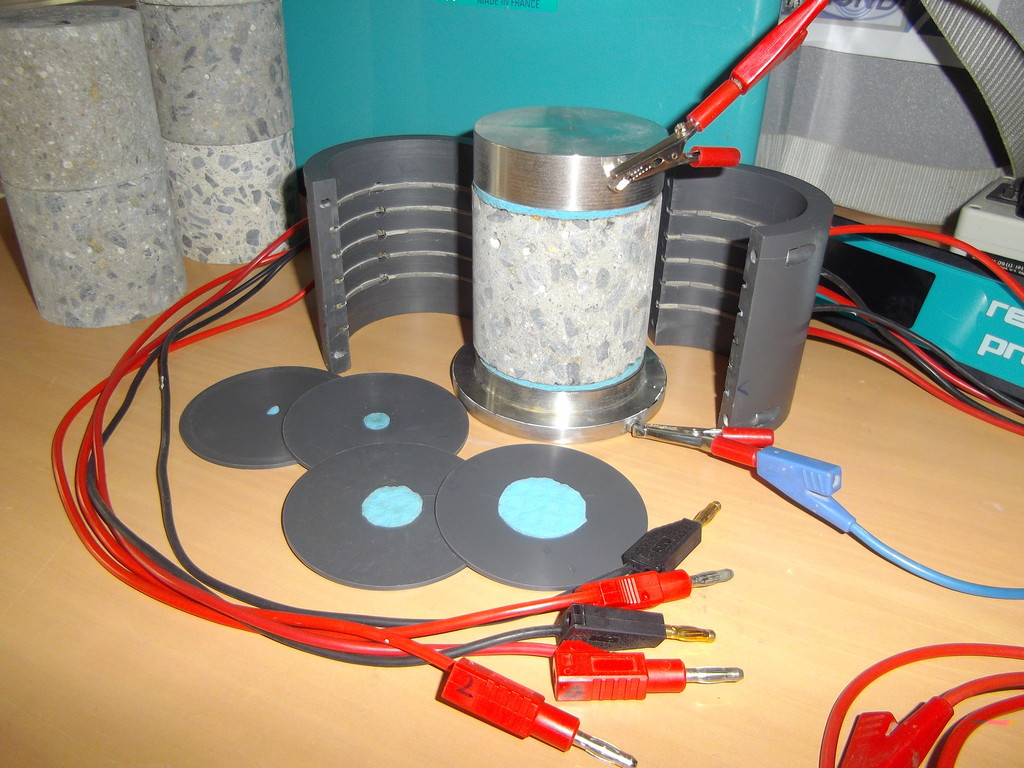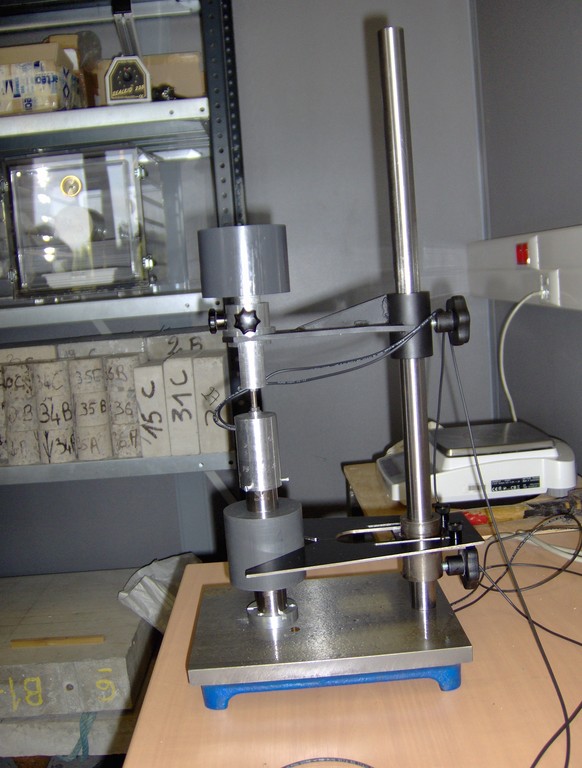Measurement cells
These measurement cells were designed to characterize heterogeneous materials in civil engineering, such as hydraulic and bituminous concrete. This has required in most cases to check that the volume of the samples (in the form of cores) can meet the "representative elementary volume" criterion, which generally stipulates that the dimensions of the sample must be greater than three times the maximum size of heterogeneities.
The first cell (electromagnetic) developed in the GeoEND laboratory in 2006 in collaboration with the LEST, from the University of Western Brittany, set dimensions of 75mm in diameter by 70mm in height for the cores to be characterized. These dimensions were then imposed for the design of the electrical and US cells.
Electrical cells
A multi-ring resistivity cell has been developed to characterize the electrical properties of granular materials in civil engineering, such as concrete (PhD thesis of R. du Plooy). This allows for the electrical characteristics of concrete mixtures to be linked, particularly in relation to their water and chloride content.
This resistivity cell is composed of two semi-cylindrical boxes fixed around the 75mm diameter by 70mm height sample to be characterized. Five ring electrodes made of conductive sponge (2mm width) are placed at equal distances on either side of the cell. The multi-ring cell employs a 4-electrode measurement configuration, in which the current is injected through two plate and disk stainless steel electrodes placed at the top and bottom of the specimen. Potential measurements are taken indifferently between two of the ring electrodes, allowing for an average measurement as well as measurements along the height of the core.
Contact

SergioPalma-Lopes
Ingénieur, Chercheur
Co-directeur de l'équipe Géophysique et Évaluation Non Destructive (GeoEND)sergio.palma-lopes@univ-eiffel.fr
+33 (0)2 40 84 59 12Bouguenais
Cellule électromagnétique
[Translate to English:]
Une cellule électromagnétique a été développée pour caractériser des matériaux granulaires de génie civil, tels que les bétons hydrauliques et bitumineux (thèse M. Adous, 2006) dans la bande de fréquence radar de 50 MHz à 1-1,2 GHz environ (suivant la permittivité du mélange). On peut ainsi relier les les caractéristiques électromagnétiques des mélanges bétons notamment en fonction de leur teneur en eau et en chlorures.
Cette cellule réalise des mesures en réflexion par une transition de guide coaxial-cylindrique. Le matériau à caractériser est placé à l'intérieur du guide cylindrique (de dimensions de 75mm de diamètre par 70mm de hauteur), ce qui permet d’avoir une fréquence de coupure haute ainsi qu'une large bande de fréquence.
Contact

XavierDerobert
Co-directeur du laboratoire Géophysique et Evaluation Non Destructive (GéoEND)
Chercheur seniorxavier.derobert@univ-eiffel.fr
+33 (0)2 40 84 59 11Bouguenais
Ultrasonic cells
An ultrasonic cell has been developed in the GeoEND laboratory to characterize granular materials used in civil engineering, such as hydraulic and bituminous concretes (post-doctoral work by F. Benmeddour, 2010) as part of the FUI MAREO project.
This cell uses compression and shear waves around a frequency of 250 kHz. It is currently located in the MAST/LAMES laboratory.
Contact LAMES

GéraldineVillain
Directrice adjointe du LAMES - Laboratoire Auscultation, Modélisation et Expérimentation sur les infraStructures - Département Matériaux et Structures
Chercheur - Ingénieur - HDR : Évaluation de la durabilité du béton armé par méthodes non destructivesgeraldine.villain@univ-eiffel.fr
+33 (0)2 40 84 57 22Bouguenais

